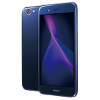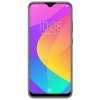Sharp Aquos Serie SHV34 vs Oukitel Y4800
Quelle est la différence entre Sharp Aquos Serie SHV34 et Oukitel Y4800. Découvrez quel smartphone offre les meilleures performances.
Performance (Benchmarks)
| 1962 | 3DMark for Android Sling Shot Extreme (OpenGL ES 3.1 / Metal) | 1267 |
| 2653 | 3DMark for Android Sling Shot | 1446 |
| 4994 | PCMark for Android Work 2.0 | 8190 |
Caractéristiques
| Sharp Aquos Serie SHV34 | Nom du produit | Oukitel Y4800 |
| Android 6.0 | Système d'exploitation (OS) | Android 9.1 |
| Bluetooth WLAN NFC | Réseaux sans fil | Bluetooth WLAN |
| Yes, microUSB 2.0 | Interfaces / connecteurs | Yes, microUSB 2.0 |
Ecran
| 1920 × 1080 px | Résolution d'écran | 2340 × 1080 px |
| IGZO LCD | Type d’écran | IPS LCD |
| Yes | Multipoints (multitouch) capacitif | Yes |
| 5.3" | Taille écran | 6.3" |
Processeur (CPU)
| Up to 2.15 GHz dual-core Kryo and 1.6 GHz dual-core Kryo | Architecture CPU | Up to 2.1 GHz quad-core ARM Cortex-A73 & 2 GHz quad-core ARM Cortex-A53 |
| Snapdragon 820 (MSM8996) | Processeur | Helio P70 |
| Adreno 530 | GPU | Mali-G72 MP3 |
Mémoire
| 3072 MB | Mémoire RAM | 6144 MB |
| 32 GB | Capacité de stockage (ROM) | 128 GB |
| microSD / microSDHC / microSDXC | Carte mémoire | microSD / microSDHC / microSDXC |
Appareil photo
| Yes, 22.6 MP | Capteur photo | Yes, 48 MP |
| Yes, 5 MP | Capteur photo avant | Yes, 16 MP |
Communication
| GSM 850 / 900 / 1800 / 1900 | 2G | GSM 850 / 900 / 1800 / 1900 |
| HSDPA 850 / 2100 | 3G | HSDPA 850 / 900 / 1900 / 2100 |
| LTE 700 / 800 / 850 / 1800 / 2100 / 2500 | 4G (LTE) | LTE 800 / 850 / 900 / 1800 / 1900 / 2100 / 2300 / 2500 / 2600 |
Géolocalisation
| Yes | GPS | Yes |
| Yes | A-GPS | Yes |
Batterie
| 3000 mAh | Capacite de la batterie | 4000 mAh |
Capteurs
| Yes | Boussole | Yes |
Design
| 73 / 149 / 7.6 mm | Dimensions | 74.8 / 157 / 8.3 mm |
| 153 g | Poids | 170 g |

